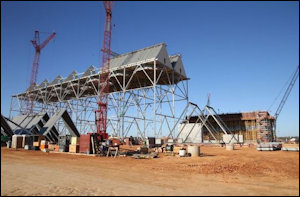
Construction at the Greensville County Power Station is well advanced. The gas-fired facility is expected to commence operations in 2018. Photo credit: Richmond Times-Dispatch
Construction has been underway at Dominion Virginia Power’s $1.3 billion Greensville County Power Station for several months now, but the company held its official ground-breaking ceremony yesterday. The event gave Dominion an opportunity to extol the virtues of the plant to its corporate family and friends. Among the key points noted by Robert Zullo with the Richmond Times-Dispatch:
The 1,600-megawatt power plan will be the largest gas-fired combined-cycle facility in North America. Construction will employ 1,000, and when that work is done, the station will employ 40 “good-paying jobs” permanently. Employing the latest gas-burning technology, Greensville will work under the strictest air pollution limits of any combined-cycle facility anywhere.
Dominion and local officials describe the plant as an economic development boon to one of Virginia’s poorest counties. Expansion of the Transco pipeline and construction of the proposed Atlantic Coast Pipeline, both of which will serve the plant, will boost supplies of natural gas to the area, putting Greensville County in the running for energy-intensive industry it could not compete for before. Furthermore, the plant will generate about $8.2 million in tax revenue, a huge sum for a county whose 2017 General Fund budget is $16.6 million.
The power company estimates that power station will save $2.1 billion over its multi-decade lifetime compared to the cost of alternative sources of electricity.
While natural gas might be the lowest cost source of electricity right now, Dominion critics question whether it will continue to be in the decades ahead as solar energy becomes increasingly cost competitive. Rather than build massive, billion-dollar power plants that could become obsolete in a decade, they say the utility should strive to maintain its flexibility in its electric-generation fleet so it can take advantage of more cost-effective technologies when they emerge.


